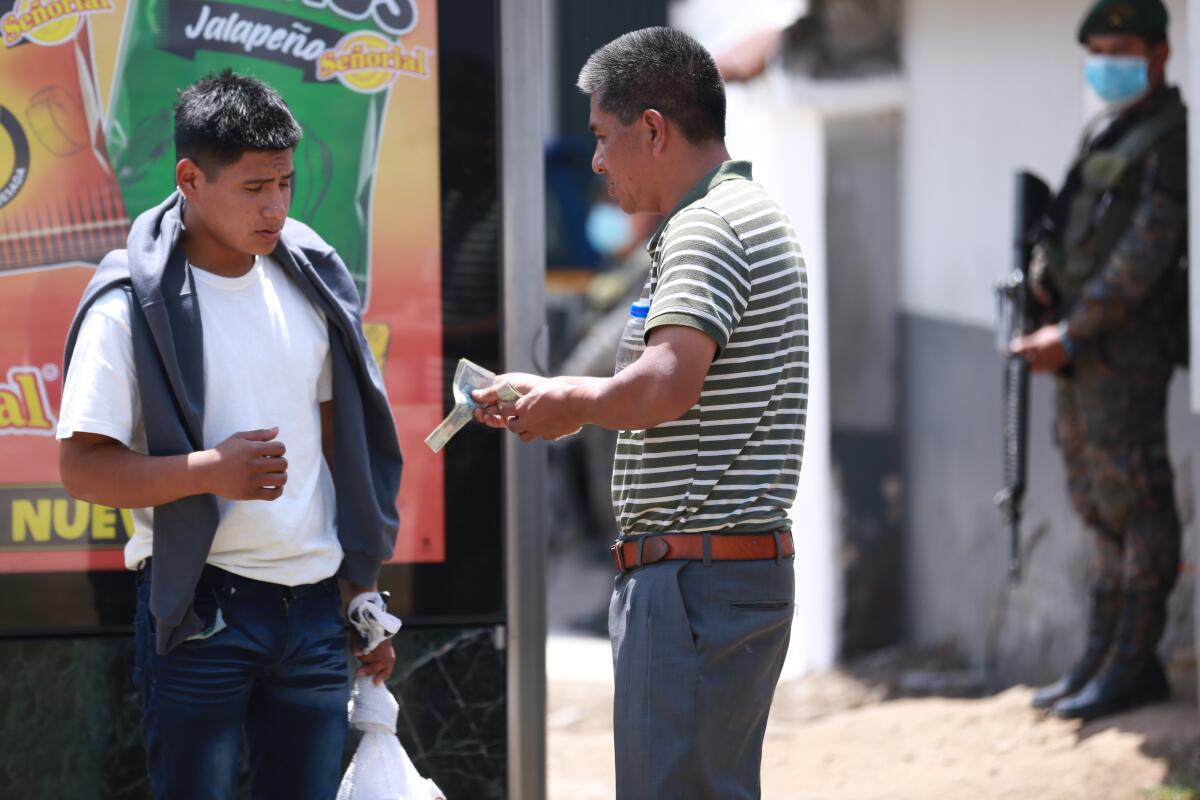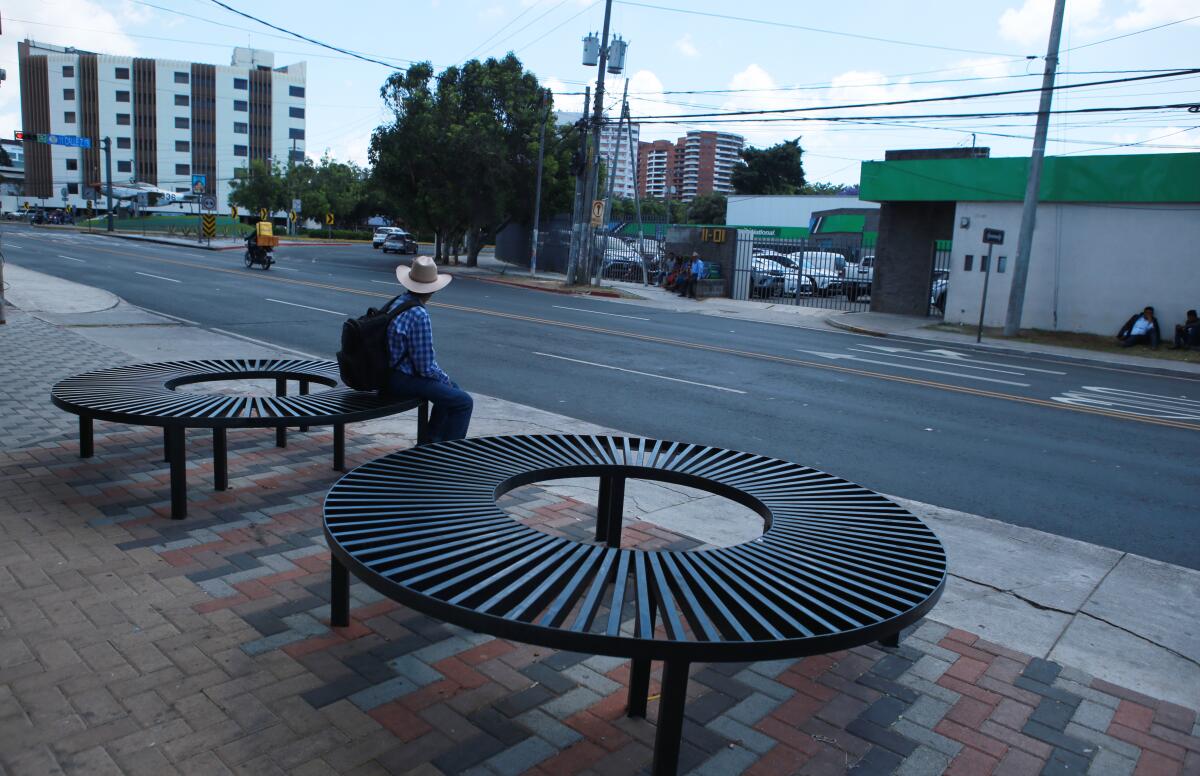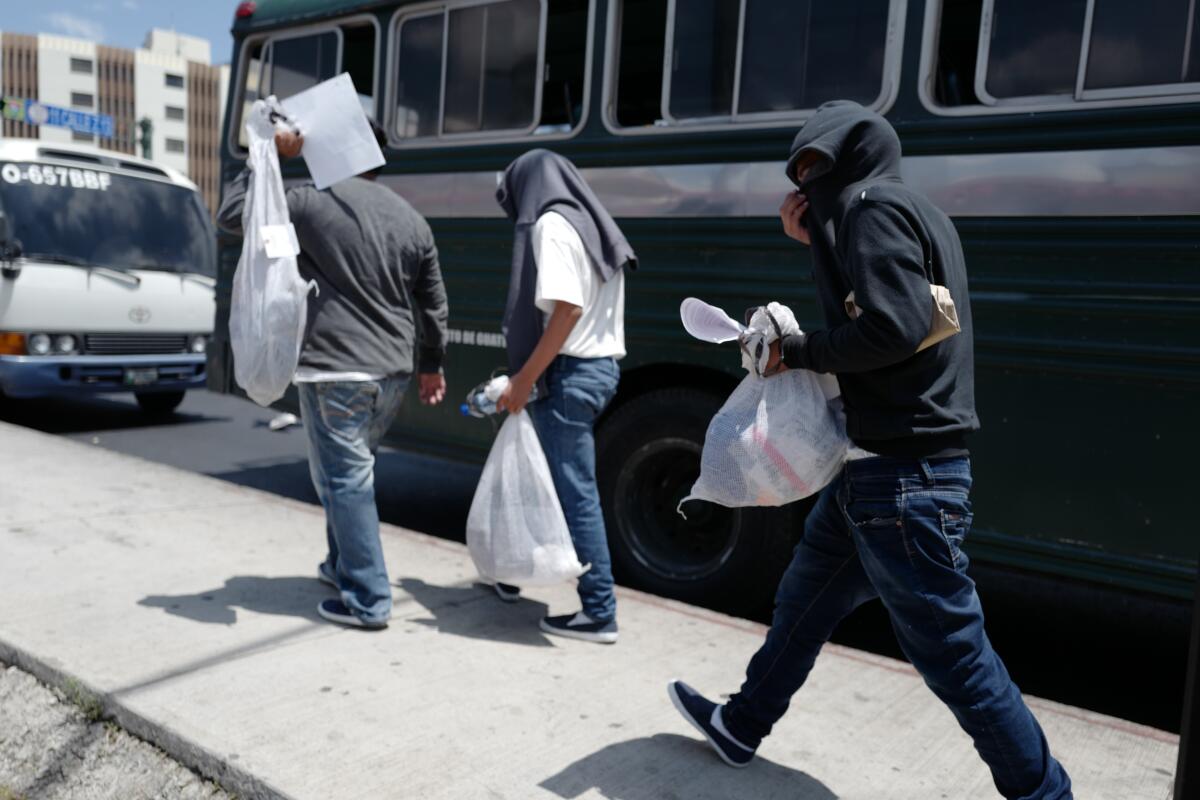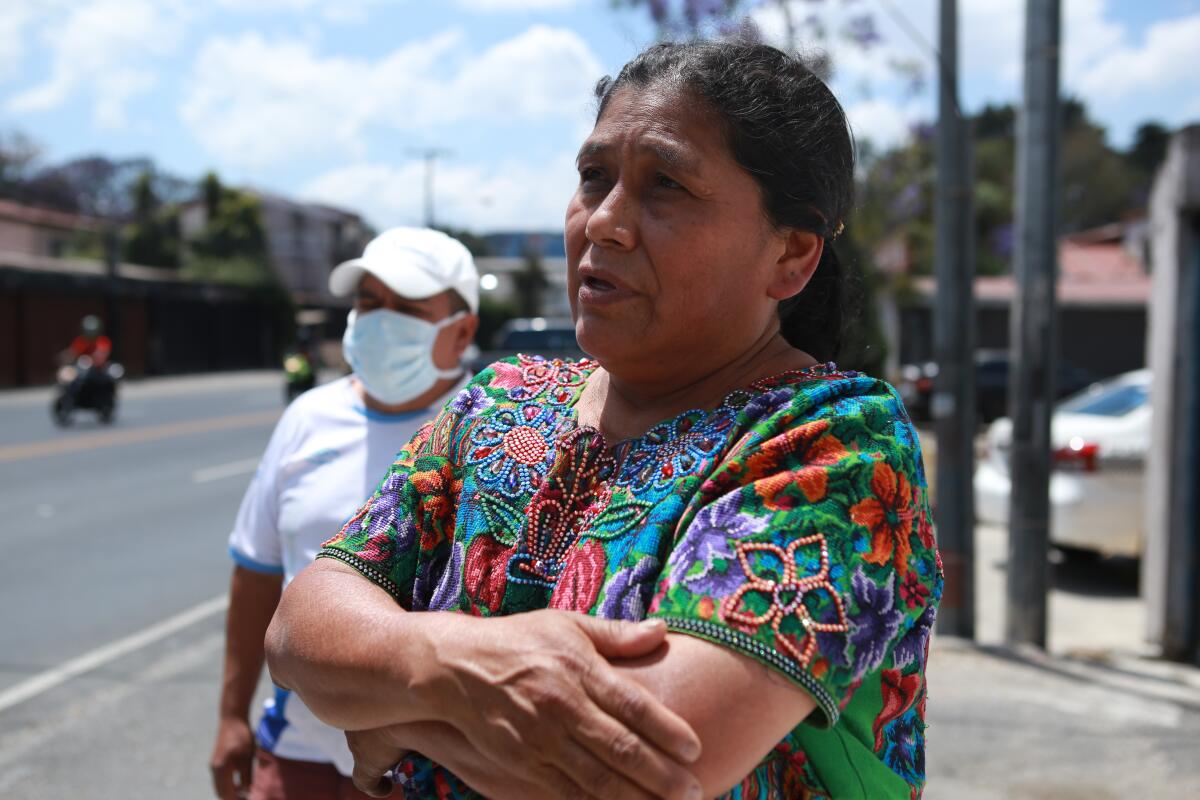Central America fears Trump could deport the coronavirus

- Share via
GUATEMALA CITY — Marcelo Ibate waited outside the big black door, eating tortillas out of a sweating plastic bag. A line of camouflaged soldiers stood beyond with large weapons and face masks.
Ibate didn’t know which day his son Eduardo would arrive or whether he’d be carrying coronavirus with him on the deportation flight from the United States, now the epicenter of the global pandemic.
“Of course I am afraid for my son, but I think he is OK,” Ibate said in Spanish as he waited outside the Air Force base where returnees are processed, attached to the commercial airport in Guatemala City. “If he’s sick, there’s not much we can do — we can only wait and care for him. I’m his father; I am responsible for him. I have to.”
After barring foreign travelers and closing its borders and businesses to try to contain the spread of coronavirus, Guatemala earlier this month became the first nation to publicly refuse deportation flights from the United States.

It didn’t last long. Just over a week ago, with assurances from the U.S. Department of Homeland Security that health protocols had been established, Guatemalan authorities allowed flights to resume — starting with 66 Guatemalans sent from Brownsville, Texas.
The group included Ibate’s 19-year-old son.
While Guatemalan law requires the repatriation of its citizens, the quick reversal underscores the tension for Latin America, a region that has taken drastic measures to avoid importing coronavirus cases from the United States.
With chronic poverty, corruption and violence and dysfunctional healthcare systems, Guatemala, Honduras and El Salvador — Central America’s Northern Triangle — are highly vulnerable to the pandemic, but they are also dependent on the U.S. for economic and security assistance. They have little leverage against a Trump administration clearly determined to continue deportations despite the risk of worsening the virus’s spread.
“It has to be agreed, not imposed,” Joaquin Samayoa, spokesman for Guatemala’s Foreign Ministry, said of deportations. “If there’s a risk, it would be the U.S.’ responsibility to contain it from going outside its borders.”
Currently all three Northern Triangle countries are continuing to accept deportation flights, but only for their own citizens.
That restriction is a blow to the Trump administration’s efforts to limit immigration. Under a controversial agreement that took effect in late November, the U.S. has removed to Guatemala nearly 1,000 Hondurans and Salvadorans whom the Trump administration has barred from U.S. asylum. But amid coronavirus, Guatemala paused that program. The pandemic has scuttled the launch of similar agreements with El Salvador and Honduras.
Officials at the White House declined to comment on the record or confirm the total number of coronavirus cases among DHS employees, migrants in detention, or those already deported, directing the Times to DHS officials for the total, which they did not provide.
Immigration and Customs Enforcement has confirmed two cases of COVID-19 among migrants in its custody, five cases among ICE employees or personnel working in detention facilities and 19 cases among other employees.
DHS spokeswoman Sofia Boza-Holman said Saturday that the Trump administration is “committed to helping slow the spread of the virus.”
Late Sunday, Guatemalan officials confirmed that a 29-year-old Guatemalan man deported from Mesa, Ariz., on Thursday began displaying symptoms and tested positive for COVID-19, the first known case in an individual removed from the U.S.
John Sandweg, former acting director of ICE in the Obama administration, said there’s “serious risk of contagion” with deportation flights, for both migrants and ICE officers on-board, as well as for the receiving country.
“They could easily suspend flights if they wanted to,” Sandweg said of the administration.
The Northern Triangle countries are among the primary places of origin for the 38,058 migrants currently in U.S. immigration detention. Of those, 6,166 have exercised their right under U.S. law to seek protection and have established their claim with immigration officials. More than 60% of all migrants in detention have no criminal convictions.
Prior to the Trump administration, many would typically have been released to family members to await court hearings.
Amid coronavirus, advocates have been filing lawsuits calling for such releases. Academics, health experts and even some administration officials and detainees themselves have said in interviews that the often crowded, unsanitary detention facilities are a “Petri dish” for the virus.
Pre-dating the pandemic, DHS’s Inspector General found 14,000 health and safety “deficiencies” at contracted detention facilities between October 2015 and June 2018. At least 10 migrants have died in ICE custody this fiscal year.
Facing criticism, ICE last week announced it would reduce enforcement actions. Instead, the agency has since added to the total detained population.
DHS officials say they are following guidelines from the Centers for Disease Control and Prevention and have implemented additional health checks on Border Patrol agents and ICE officers. They have also started to take the temperature of migrants before they board flights, to either other detention centers or to other countries.

“The CDC’s top healthcare experts have rigorously worked with DHS to develop the best guidelines and practices to prevent the spread of COVID-19 across both the northern and southern border, in our immigration housing centers and [on] our repatriation flights,” said Health and Human Services Department spokeswoman Caitlin B. Oakley in response to requests for comment from the White House.
Those steps may be insufficient.
“You can have the virus without having a fever,” said Adam Isacson, director for defense oversight at the Washington Office on Latin America. “Otherwise we could all be going to bars right now and just having our temperature taken before we went in.”
David Marin, a senior ICE official in Los Angeles, expressed concern that if countries start to refuse deportation flights, U.S. detention space would soon fill up.
Now, the U.S. is using the planes deporting migrants to evacuate stranded Americans. “ICE Air” brought home more than 460 U.S. citizens from Honduras and El Salvador last week after dropping off deportees, the agency said Saturday.
ICE said earlier it would continue returning U.S. citizens from the Northern Triangle on deportation flights for “the duration of the COVID-19 pandemic,” and that the operations could expand to other countries.
Some stranded U.S. citizens fear that by using ICE Air, the administration is needlessly exposing them to the virus.
Amy Cohen, a child psychiatrist who has served as a trauma expert for lawsuits against Trump immigration policies, became stuck in Honduras after arriving for work on March 15. She has lupus, an autoimmune disease, which puts her at extra risk.
“Wouldn’t it be ironic if the way I get sprung from here happens to be a flight on which people were deported?” she asked. “I wouldn’t refuse it, but my God, how unnerving would that be?”
Earlier this month, the Honduran government announced that three of its citizens who were deported had exhibited symptoms of coronavirus. Last Sunday, Honduran citizens deported from the U.S. fled mandated quarantine upon their arrival, according to reports. Cohen was supposed to be on the return flight, but it was canceled, she said.
Last Monday, the U.S. deported 85 Guatemalans from El Paso, including 29 children. When they arrived, Guatemalan health officials found that a 16-year-old and a 14-year-old had high temperatures. The rest of the returnees, as well as 20 Guatemalan officials processing them, had to be isolated. The teenagers ultimately tested negative for COVID-19, according to the Guatemalan health ministry.
Asked whether the incident had caused alarm among Guatemalan officials, Samayoa, the Foreign Ministry spokesman, said it was “scary” but “turned out fine.” If the children had tested positive, he added, “there might be some eyebrows raised.”
DHS officials did not respond to requests for comment on how the deported minors could arrive with fevers if they were tested before boarding.
“Detainees are screened prior to boarding and will not be allowed to board if they have a fever,” said ICE spokeswoman Mary Houtmann.
A week later, on Monday, three more Guatemalan children deported from the U.S. arrived with high temperatures and are currently awaiting testing, according to Guatemalan officials.
Hours after Eduardo’s deportation flight landed, the black door from the airbase suddenly opened, and waves of young men emerged. They held white mesh bags with their belongings, and many hid their faces from cameras; few had face masks or gloves. They headed for buses provided by the government for transit toward their hometowns. Guatemala’s president had shuttered the country’s bus system days before.

“I am here for my son,” said Rosa Bocel, whose colorful indigenous dress stood out as she and her husband searched for their 20-year-old in the crowd. “I live for my children.”
Like Ibate, Bocel and her husband had traveled via an expensive private taxi from a small city near Guatemala’s famed Lake Atitlán. The tourism upon which their family of 14 relies has all but dried up due to coronavirus.
“He left out of necessity,” she said of her son. “Because here there is nothing, and now, even less.”

Ibate said that between the debt they took on to pay a coyote for Eduardo’s trip north and the damage coronavirus has wrought on Guatemala’s economy, his family is even worse off than before.
“This is why people leave … Life is almost impossible,” he said. “Now, the markets are closed, the stores are closed — everything! If everyone closes their borders, how are we going to eat?”
Back home in Sololá and job hunting, Ibate’s son Eduardo had one word for his detention in Laredo, Texas: “suffering.” Of some hundred migrants he said were crammed into one frigid cell — he didn’t know if any were sick — he spoke to few, concentrating only on trying to stay warm.
Still, he had little hope of staying long in Guatemala.

“I want to go north again,” he said. “I don’t know how, but my family has to get by.”
As coronavirus cases creep up in Guatemala, Ibate is resigned to their fate, he said.
“If God has permitted this virus,” he said, “there is nowhere to go.”
Times staff writer Cindy Carcamo in Los Angeles contributed to this report.
More to Read
Get the L.A. Times Politics newsletter
Deeply reported insights into legislation, politics and policy from Sacramento, Washington and beyond. In your inbox three times per week.
You may occasionally receive promotional content from the Los Angeles Times.











